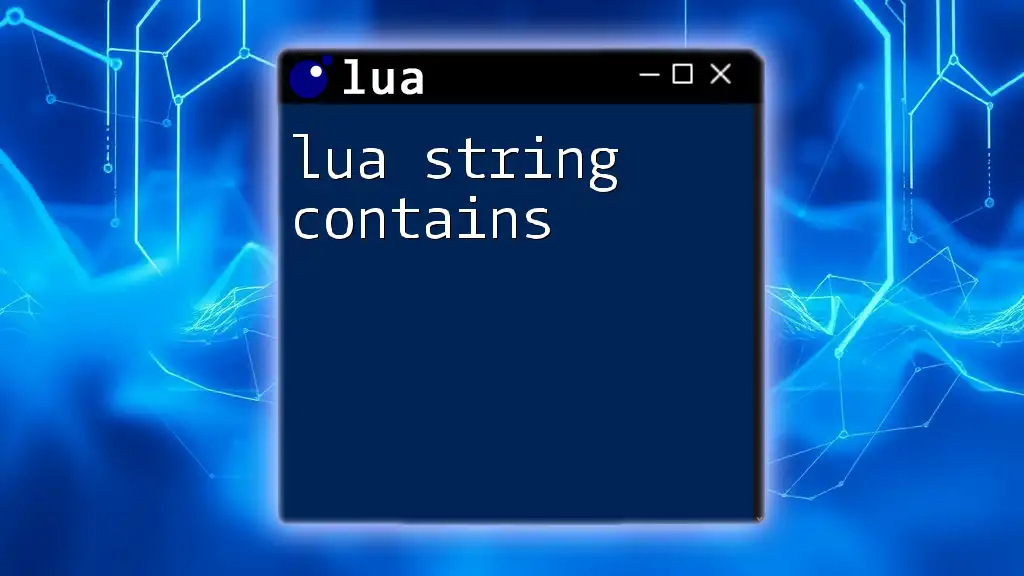In Lua, you can check if a string is contained within a table by iterating through the table and comparing each element to the target string.
Here's a code snippet demonstrating this:
function containsString(table, str)
for _, value in ipairs(table) do
if value == str then
return true
end
end
return false
end
local myTable = {"apple", "banana", "cherry"}
print(containsString(myTable, "banana")) -- Output: true
print(containsString(myTable, "orange")) -- Output: false
Understanding Tables in Lua
What is a Table?
In Lua, a table serves as the primary data structure for storing collections of values. Unlike traditional arrays in other programming languages, tables in Lua are more versatile because they can contain various data types, including numbers, strings, and even functions. This flexibility allows you to create complex data structures with ease, such as lists, dictionaries, and sets.
Creating and Initializing Tables
Creating a table in Lua is straightforward. You can initialize it as follows:
local fruits = {"apple", "banana", "cherry"}
In this example, we've created a simple array of strings. You can also create tables with key-value pairs, which allows for more organized data management:
local fruitColors = {
apple = "red",
banana = "yellow",
cherry = "red"
}
With both techniques, you're well-equipped to organize data effectively.

Basics of Strings in Lua
Working with Strings
Strings in Lua are immutable sequences of characters. Lua provides various built-in functions that allow you to manipulate strings effectively. Among these, string.find(), string.match(), and string.gsub() are particularly useful for matching and searching through strings.
String Comparisons
It’s essential to remember that string comparison in Lua is case-sensitive. This means that "apple" and "Apple" are considered two distinct strings. When checking for string containment, it’s important to ensure that your strings are compared accurately to avoid unexpected results.

Checking for String Containment in a Table
Iterating Through a Table
To verify whether a specific string is present in a table, you can iterate through the table with a simple loop. Here's an example:
local fruits = {"apple", "banana", "cherry"}
local searchString = "banana"
for _, fruit in ipairs(fruits) do
if fruit == searchString then
print(searchString .. " is in the table.")
break
end
end
In this snippet, we use the `ipairs()` function to iterate through the `fruits` table. When a match is found, a message is printed, and the loop is exited for efficiency.
Using Functions for Reusability
To enhance code reusability, you can encapsulate the logic into functions. For contest-aware checks, here’s a versatile function that checks if a string is contained in a table:
function contains(table, searchString)
for _, value in ipairs(table) do
if value == searchString then
return true
end
end
return false
end
You can then call this function like so:
if contains(fruits, "cherry") then
print("Cherry is in the list.")
end
This approach not only makes your code tidier but also enhances reusability across multiple checks without rewriting the logic.

Advanced Techniques
Using `table.concat()` to Simplify Search
Another useful technique for searching a string within a table is employing the `table.concat()` method. This function joins table entries into a single string, which allows for simpler string functions. Here’s how to do it:
local concatenatedFruits = table.concat(fruits, ", ")
print(concatenatedFruits:find("apple") ~= nil and "Found apple" or "Not found")
In this example, `table.concat()` creates a single string from all the fruit names, making the search significantly more manageable.
Combining Comparison and Pattern Matching
Lua’s pattern matching feature can also enhance string containment checks. You can create a function utilizing string.match() to find partial or patterned matches:
local function findPattern(table, pattern)
for _, value in ipairs(table) do
if string.match(value, pattern) then
return true
end
end
return false
end
You can call this function to find strings that match a specific pattern, such as those starting with a letter:
if findPattern(fruits, "^b") then
print("There is a fruit starting with 'b'.")
end
This shows the power of Lua’s breath of search capabilities beyond literal comparisons.

Common Pitfalls and Best Practices
Case Sensitivity Issues
When checking for string containment, case sensitivity can lead to missed matches. To avoid this, consider standardizing your strings by converting both the search string and the table entries to the same case (e.g., lower case) before comparison:
local function containsIgnoreCase(table, searchString)
searchString = string.lower(searchString)
for _, value in ipairs(table) do
if string.lower(value) == searchString then
return true
end
end
return false
end
This ensures that comparisons are accurate regardless of how input strings are cased.
Efficient Searching Techniques
For large tables, efficiency becomes critical. If your applications frequently check for the presence of strings, consider using a set-like approach by storing strings as keys in another table, facilitating a faster O(1) lookup:
local fruitsSet = {}
for _, fruit in ipairs(fruits) do
fruitsSet[fruit] = true
end
if fruitsSet["banana"] then
print("Banana is in the set.")
end
This changes the complexity of your lookups and can significantly improve performance in data-heavy applications.

Conclusion
Understanding how to check for a lua string contained in table is a fundamental skill that enhances your programming capabilities in Lua. By utilizing tables, functions, and advanced techniques like pattern matching, you can streamline your string searching processes. As you practice and experiment with these tools, you'll get better at manipulating Lua strings and tables efficiently, paving the way for more complex and powerful coding solutions.

Additional Resources
For a deeper understanding, explore the [official Lua documentation](https://www.lua.org/manual/5.1/) and consider enrolling in online courses or reading books on Lua programming to expand your expertise even further.

















